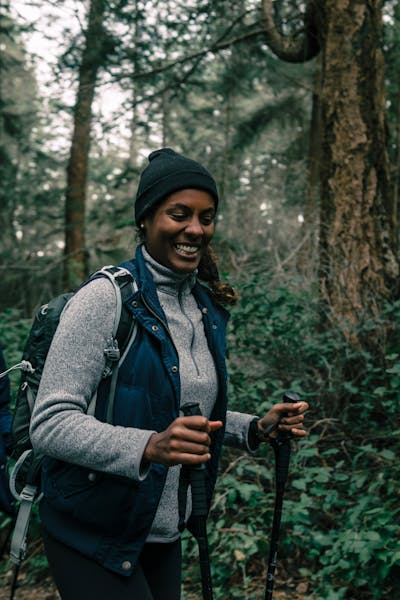
Hiking is a rewarding way to immerse yourself in nature, get some exercise, and connect with your surroundings. For many hikers, trekking poles have become an essential part of their gear. They not only enhance stability but also make your hike more enjoyable and less taxing on your body.
In this guide, I cover all aspects of using trekking poles correctly; from their benefits, to choosing, adjusting and how to use them on different terrains. If you’re sitting on the fence when it comes to trekking poles, this guide will help you make your decision along with this guide that discusses the pros and cons of trekking poles.
Benefits of Using Trekking Poles
Extra Stability and Balance
Trekking poles provide crucial support when navigating rugged or flat terrain. They help you maintain your balance, especially on uneven surfaces, allowing you to focus on enjoying the hike rather than worrying about stumbling.
Joint and Muscle Strain Reduction
Hikers often experience strain in their joints and muscles, particularly on inclines and declines. Trekking poles distribute your weight and lessen the load on your knees and hips, promoting a more comfortable hike.
Shock Absorption
The poles act as shock absorbers, taking pressure off your knees during downhill stretches. They can be a game-changer for individuals with osteoarthritis, obesity, Parkinson’s disease, or multiple sclerosis.
Improved Posture and Injury Prevention
Using trekking poles encourages better posture by promoting a more upright stance. This not only prevents injuries but also improves stamina, allowing for longer, enjoyable hikes.
Enhanced Caloric Burn and Upper Body Workout
While traditional trekking poles focus on stability, Nordic walking poles offer an upper-body workout, helping you burn additional calories on your adventures.
Multi-functional Use
Trekking poles can double as supports for mounting cameras or setting up tents, adding to their versatility in the great outdoors.
How to Choose and Adjust Trekking Poles
Choosing the right trekking poles is essential for maximizing benefits. Consider these height and terrain guidelines:
- Under 5’1” or 155 cm: 100 cm
- 5’1” – 5’7” or 155 – 170 cm: 110 cm
- 5’8” – 5’11” or 173 – 180 cm: 120 cm
- 6’ and above or 183 cm: 130 cm
Adjustable poles give you the flexibility to adapt to different terrains, allowing you to shorten them on uphill sections and lengthen them on downhill. Ensure the poles are set at the right length: when the pole tip is on the ground, your elbow should form a 90-degree angle.

For varied terrains, look for poles with interchangeable tips suitable for different surfaces such as soft earth, ice, pavement, snow, or sand. Collapsible poles are essential as they can be strapped to your backpack when not required, for example, when scrambling on rocks and free hands are required.
Proper Grip and Strap Usage
Grip Technique
Grip your poles loosely between your thumb and forefinger to reduce fatigue during long hikes. This relaxed grip allows for more natural hand movement, reducing strain.
Wrist Straps
Utilizing wrist straps is essential for maintaining support, especially on uneven terrain. Proper placement of the straps (L for left and R for right) helps distribute weight evenly and minimizes the chance of blisters.
Grip on Challenging Terrain
On steep descents or challenging terrains, use a firmer grip for added control and stability.
Using Trekking Poles on Different Terrain
- Flat Terrain: On flat surfaces, alternate planting poles with the opposite hand and foot to maintain balance and rhythm.
- Uphill Hiking: Shorten the poles to use them for transferring energy from your legs to your upper body. Plant the poles close to your body for a little push without pulling.
- Downhill Hiking: Lengthen the poles by 5-10 cm and plant them ahead of you for a braking effect. Take small steps and keep your knees slightly bent. Zigzagging on steep paths can help maintain balance.
Ascending and Descending Stairs
- Going Down: Plant both poles on the next lower step, then step down (plant, step, repeat).
- Going Up: Push yourself upwards by planting poles next to your feet, then step up (push, step, repeat).
Walking Technique
Keep your elbows close to your sides and flick the poles forward with each opposite arm/leg motion. Initially allowing the poles to drag behind you also helps you incorporate them naturally into your stride. Use the poles lightly for stability or push them for braking on inclines. When tackling hills or stairs, use both poles together to gain a stable advantage.
Backpack Considerations
Choosing the right backpack is crucial. Opt for a daypack or larger backpack that doesn’t interfere with pole movement. This allows you to carry essentials like water and layers of clothing without compromising your ability to use your trekking poles efficiently.
Storage and Maintenance
To Maintain Your Trekking Poles
- Mark the adjustable sections for quick setup.
- Clean and dry the poles after wet hikes to keep them in top condition for your next adventure.
My Final Thoughts
Using trekking poles correctly can significantly improve your hiking experience, from enhancing balance to reducing fatigue. By understanding the benefits, mastering the proper techniques, and choosing the right equipment, you can make the most of your time on the trails. Remember, the key to a great hiking adventure is to enjoy the journey while taking care of your body! Happy Hiking!
Do you use trekking poles? Or do you have questions about trekking poles? Please leave a comment below.

Hey Lyn,
Your guide is a treasure trove of information! I’m totally on board with your thoughts on the advantages of trekking poles. Even though I’m more accustomed to long city walks, I can see how they’d be a game-changer for hiking, particularly on tricky terrains or steep descents. Your emphasis on how they alleviate joint stress and enhance posture hits home; I can imagine the difference they’d make to how my body feels after a hike.
The comprehensive explanation on selecting and adjusting the poles for varying terrains is much appreciated. It’s an aspect many might skip, but as you’ve pointed out, it’s key to fully harness their potential. The multi-functionality of trekking poles, from shock absorption to acting as tent supports, truly marks them as an essential tool for hikers.
Your article is a fantastic guide for anyone uncertain about trekking poles or aiming to utilize them more effectively. Thanks for sharing such a detailed and well-articulated guide!
Looking forward to my hiking adventures!
All the Best,
Eric